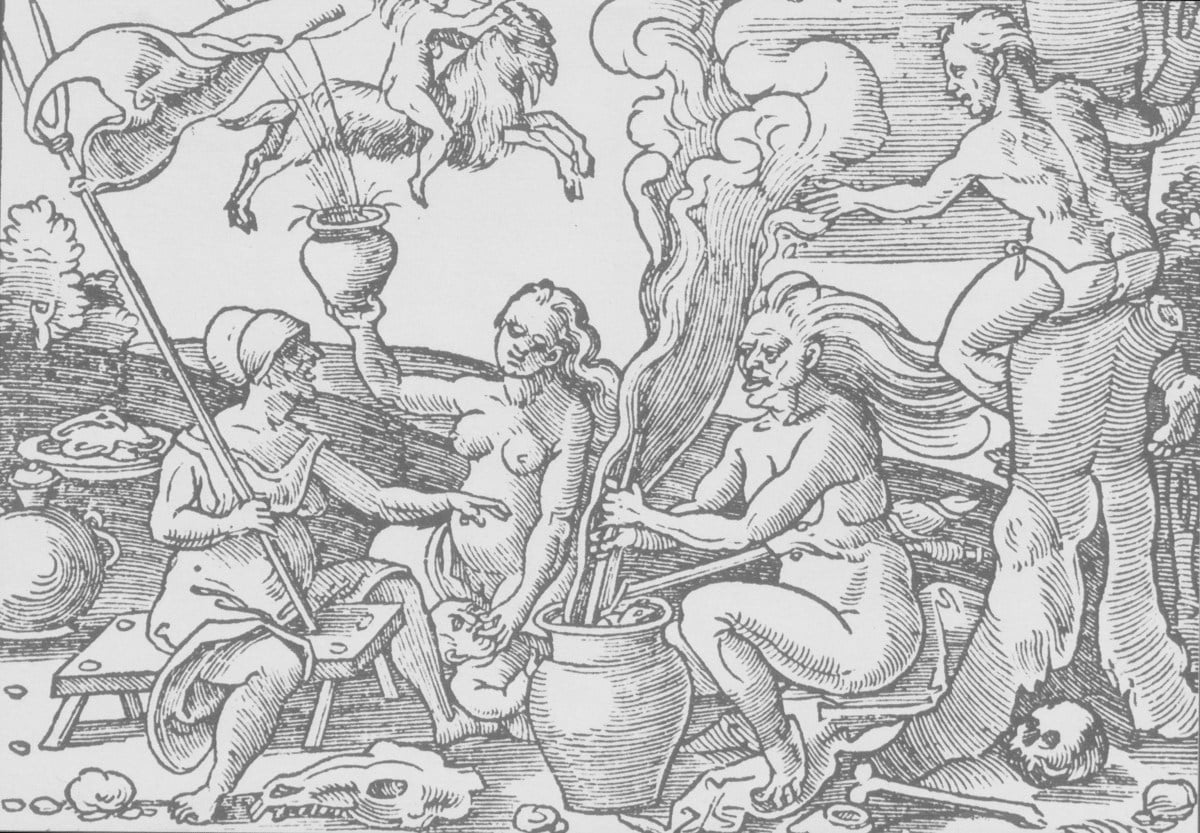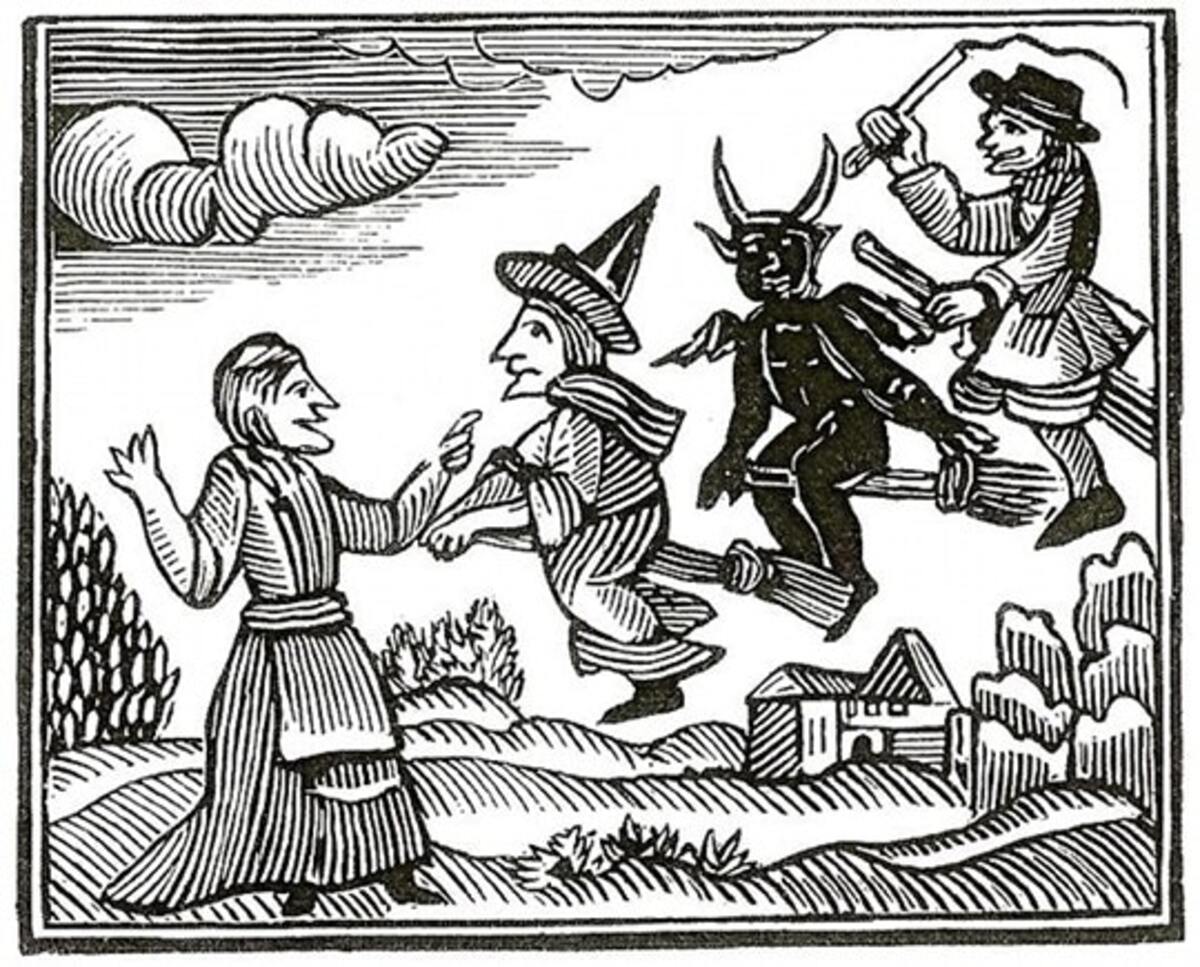It’s Halloween time. And there are few Halloween images more iconic than a witch on her broomstick, flying through the sky, usually across a full moon. It’s an image we nearly take for granted. We just assume that witches are some sort of supernatural creatures who can fly simply by magic, and we don’t examine it further. But there’s lots of history and mystery just in that one trope, and a lot more sex and drugs (not rock and roll though) behind broomstick flight than you might imagine. So today we’re going to discuss how a witch can fly.
Historically, witches have been able to fly via the use of “flying ointments.” These were salves or unguents made of generally toxic plants that were applied to the body. When absorbed, these ointments, because they contained deliriants (not hallucinogens) gave the feeling of flying. So the people who used them (usually women) were getting high, almost literally. (Indeed I’ve seen it theorized that this is one source for the actual term “getting high”).
The “flight” of witches, or their transformations, was never literal—it was a figurative flight of the spirit, into another realm or plane of existence. The use of flying ointment can be part of what’s called “sabbatic witchcraft,” but we honestly don’t know the full history because so few records exist, given that this was generally a secretive folk magic practice.
Like many psychoactive drugs used in religious rites, the use of flying ointment has pretty ancient roots. According to the website Bane Folk, a website and online source dedicated to the use of “baneful” plants in magic and healing:
Flying ointments are mentioned in Apollonius Rhodius’ The Argonautica from 200 BCE, Lucius Apuleius’ The Golden Ass from around 160 CE, and the oldest possible reference is in Homer’s The Iliad from around 800 BCE where the goddess Hera uses an oil of ambrosia to fly to Olympus, while never touching the earth.
Flying ointments were being written about in the 13th century by people like the famous alchemist Albertus Magnus, who wrote about those using “black magic” using Henbane for their rites. It’s thanks to writings like his and others that we know what the ingredients went into flying ointments in the middle ages.
As noted above, henbane was a popular ingredient for flying ointment. Henbane comes from the nightshade family, and most flying ointments include some sort of nightshade. Nightshade (or Solanaceae) plants are extremely wide-ranging and common: the family includes tomatoes, eggplants, and peppers, as well as extremely poisonous plants like belladonna, henbane, mandrake, or datura. It’s the later that are used in flying ointments, so please don’t smear yourself in eggplant marinara and try to go on a spiritual journey.
A 1276 record of flying ointment by Theodoric of Cervia was made of: “Henbane, mandrake, hemlock, lettuce, opium, ivy, climbing ivy, lapathum, juice of unripe mulberry, and spurge flax.” This version was taken by soaking a sponge in the mix and inhaling it. Three of the ingredients here—mandrake, hemlock, and opium—are well known psychotropic and deadly plants. Hemlock especially can be deadly. But they are also psychoactive when used in the right amounts.
Most flying ointments were, as we’ve mentioned, salves that were rubbed onto the body. These were made with rendered animal fat or vegetable oil of some kind. It’s in the use of fats that the history of flying ointments take a truly dark turn beginning in the renaissance, and coinciding with the rise of witch hunts and trial in Europe.

Though witches had been accused before, the real epidemic of witch trials beginning in the 15th century stems almost entirely from the publication of one book, the Malleus Maleficarum, or “Hammer of the Witches” written by Heinrich Kramer, which was used to find witches and included passages about how witches would use ointments made from the fat of children to fly. This belief gained traction and was repeated by other authors, including Francis Bacon, who wrote:
The ointment that witches use is reported to be made of the fat of children digged out of their graves; of the juices of smallage, wolf-bane, and cinque-foil, mingled with the meal of fine wheat. But I suppose that the soporiferous medicines are likest to do it; which are henbane, hemlock, mandrake, moonshade, tobacco, opium, saffron, poplar-leaves.
It’s interesting to take a step back here and look at this through modern eyes. Because people are still making this kind of crap up and believing it.
There was no baby fat in historical flying ointments, let’s be clear, but the witch hunters needed an element to their accusations to make them truly sensational. They alleged women flew to sabbats to sacrifice babies to the devil, have sex with the devil, and used the bodies of children for dark rites. That sounds exactly like what QAnon believers are still accusing Democrats and members of the “deep state” of doing. You’d think after 600 years folks would come up with better, more plausible accusations, but I guess nothing beats babies?
Now. Where did the brooms come into all of this?
Well, one theory goes that flying ointments are most effective when applied to mucous membranes, like the armpits. But what’s an extremely convenient (and very fun) area that contains mucous membranes? The vulva. This is where the sex toys come in.
According to some, including Michael Pollan in The Botany of Desire, flying ointments were administered “vaginally using a special dildo.” This idea comes from several records of women in the middle ages and renaissance who were allegedly caught using flying ointments and accused of witchcraft.
In 1324, Ireland saw its first witch trial, where Lady Alice Kyteler was accused of witchcraft. Records note that investigators found “a pipe of oyntment, wherewith she greased a staffe, upon which she ambled and galloped through thick and thin, when and in what manner she listed.”
Another account is found in 15th-century work by Jordanes de Bergamo, Quaestio de Strigis. He records that on “certain days or nights they anoint a staff and ride on it to the appointed place or anoint themselves under the arms and in other hairy places.” Another confession from Antoine Rose, the witch of Savoy, which was compelled under torture in 1477, according to Kristen J. Sollee in Witches Feminists Sluts, alleges the devil gave this woman a stick 18 inches long which she would anoint and ride and be “carried through the air.”
We can’t know for sure if such practices occurred anywhere outside of witch-hunters’ feverish imagination, as too much has been lost to the past. But these accounts provide an extremely probable explanation for the old image of a witch flying through the air on a broomstick. In researching this I have found modern witches who currently use flying ointment in their personal practice, and who claim the application of it to the genitals is “pure myth.” But then again, that account takes as true the inclusion of baby fat in the recipe, so it may just be trying to sanitize things. And of course, the persecution of “witches” has always had a lot to do with suppressing female sexuality. Brooms also have other associations in witchcraft both modern and historical, from cleansing a space to tapping into the magic of trees, but it’s not surprising that people afraid of witches would imagine more sinister and sexual connotations.
Flying ointment has gained new popularity in recent years as more modern witchcraft practitioners have explored spirit flight. There are all sorts of flying ointments (mostly made from non-poisonous plants like mugwort) available online and on Etsy. And we’ve seen the use of it depicted in media as well (as we saw in Portrait of a Lady on Fire), and as society loosens up about their fear of psychoactive plants, we will likely only see the interest increase.
But we do want to end with a warning to not jump into making your own flying ointment at home. It’s best left to professionals, and there are some places you really don’t want splinters.
(via: Scientific Inquirer, image: Unattributed Woodcut, circa 1400; public domain)
Want more stories like this? Become a subscriber and support the site!
—The Mary Sue has a strict comment policy that forbids, but is not limited to, personal insults toward anyone, hate speech, and trolling.—









